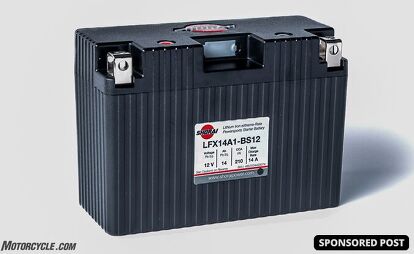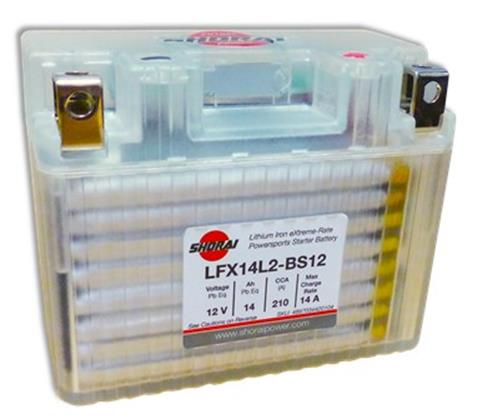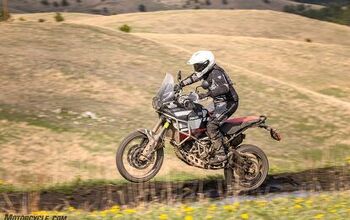Lithium Motorcycle Batteries: Myths VS Realities - Updated
Lighter and stronger, they almost reach superhero status
Let’s take a moment to acknowledge the lead-acid battery. Invented in 1859, the first rechargeable battery has been honed to an extremely high state of tune. In fact, it is so ubiquitous that almost every gasoline-powered motor vehicle on the planet uses them to start their engines. Lead-acid batteries are cheap to manufacture (and recycle), flexible in their application, and pretty dang reliable. They are the very definition of a known quantity. Unless you have one of the flagship hypersport bikes or one of a select group of dirt bikes, odds are, your motorcycle came with a lead-acid battery straight from the factory. Lithium-based batteries are, comparatively, new on the scene and, as is true of many nascent technologies, have gone through some growing pains. However, lithium batteries have developed quite quickly and are now on the cusp of a significant challenge to the lead-acid hegemony. Still, lots of riders are asking why would we want to mess with a good thing?
As good as lead-acid batteries are, they have some significant flaws. First, they are heavy. Second, they contain a large amount of lead, which is bad for the environment if not recycled, and the acid that interacts with the lead is corrosive, should it leak from the battery case. Third, they have a limited number of discharge/recharge cycles compared to lithium batteries. Finally, in storage, their self-discharge rate can be as great as 1% per day in hot conditions. Lithium batteries address all of these issues.
To learn more about lithium batteries, how they relate to lead-acid batteries, and what the future holds for them, we talked with Representatives from two of the major lithium battery manufacturers in the U.S. At Shorai , we spoke to Phuc Lam, TK, for information about how Shorai has approached lithium batteries over its 11 years of manufacturing them. We also spoke to Jason Levitt, President and Founder at Full Spectrum Power , whose company has also been a manufacturer of lithium batteries for more than ten years.
Levitt gave us a wealth of background information on lithium batteries, but his primary point was to say that the weight issue has been overplayed. Yes, they are lighter. He believes we should be more excited about the voltage they deliver: “Higher resting voltage, means the bike will start more quickly. Your resting voltage will be higher. So, that means a more consistent spark and hotter spark, running a lithium battery than lead-acid.”
Lam also stressed that the primary advantage of lithium batteries is not the weight, stating that “the cycle life is the primary benefit of lithium batteries.” In layman’s terms, this is how many times you can discharge and recharge a battery. Lam stated that the duty life of lithium batteries is as much as 5,000 cycles vs a lead-acid battery’s 1,000 before performance goes down. This is a significant difference.
Lithium battery myths
We’ve all heard stories about lithium batteries that have caught fire. While we certainly don’t want that to happen to our bikes, the fear is mostly misplaced. The fires we typically read about are with lithium-ion batteries, the types of batteries that power small electronics, like smartphones and laptop computers. In motorcycle applications, the batteries are constructed from a lithium-iron-phosphate blend that gives up a little in its power density for significantly more chemical stability than traditional lithium-ion batteries.
Additionally, in the case of powersports lithium battery failures, most of these occurred in batteries without Battery Management Systems (BMS). The electronics necessary to balance the discharge/recharge loads on a lithium battery have advanced to the level that the BMS shuts the battery down when an overcharge situation that could potentially lead to overheating and/or fire is encountered.
We’ve also frequently heard that lithium batteries don’t last as long as lead-acid batteries. This myth will need to be addressed in several ways. First, in the case of a complete discharge, it is possible to drain a lithium battery down to a level that it cannot recover from. However, BMS circuitry now prevents that from happening by shutting down the battery before the power drain can reach a level that will damage it. Unfortunately, not all lithium powersports batteries have BMS. If you’re shopping at the very bottom of the price range for lithium batteries, you’re likely not going to get this level of protection. The lack of a BMS is not the only way that low budget lithium battery manufacturers cut their costs either.
For a while in the powersports industry, the lithium battery market was a bit of the Wild West, and unscrupulous low-end manufacturers were scooping up lithium cells that were rejected by name-brand manufacturers for pennies on the dollar. This allowed them to make money even with bargain-basement battery prices to the consumer. Not surprisingly, these cells tended to fail more often than quality ones, which damaged the reputation of lithium batteries and made many people falsely believe they were unsuited for motorsports use. If you absolutely insist on buying a super-cheap lithium battery, do your research before you spend your money. If it doesn’t have BMS, run away. The battery will be a danger to both your motorcycle and your wallet. Having to replace the battery in short order will be the least of your concerns.
Another myth about lithium batteries is that they are less resistant to parasitic drains, such as an alarm system. Again, this comes from the era before lithium BMS were common. Typically, the alarm or another accessory would completely drain the battery, and the owner would not notice this for a while. With a lithium battery, this extended flatline will turn it into a paperweight. High-quality lead-acid batteries may bounce back from this kind of abuse a couple of times. However, not all lead-acid batteries will survive this mistreatment even once, either.
Finally, when it comes to longevity, lithium batteries have a conservative discharge/recharge cycle capacity two-to-four times that of lead-acid batteries. So, if a lead-acid battery can last around 500 deep discharge cycles (or 80% depth of discharge cycles), a lithium battery can perform the same task upwards of 2,000 times, negating much of the upfront premium price paid for lithium batteries.
Lithium batteries are also accused of being unsuitable for use in below-freezing temperatures. The truth is that both lead-acid batteries and lithium batteries are affected by the cold. Lam says Shorai batteries, like all lithium batteries, perform in the inverse of lead acid ones. With traditional batteries, you have to get the bike started right away before the voltage drops. With lithium batteries, the internal resistance is higher when the battery is extremely cold. So, you need to build up to the battery’s full cranking power.
The trick to starting your bike with a lithium battery is to warm the battery up first. The easiest way is to put a load on it for a couple of minutes. By turning on a power draw, like a headlight or an electric vest, the battery warms itself as it delivers the electricity, and the amount of electricity available increases as the battery warms up. While some lithium battery manufacturers say to go ahead and repeatedly crank the engine anyway – since the large load will warm the battery the quickest way possible – we’d recommend against that, unless you like replacing the gears in your starter motor.
Lithium battery realities
As we said at the beginning of this article, the most common advantage that most riders have heard about lithium motorcycle batteries is that they weigh significantly less than lead-acid batteries. This is true. Getting roughly 70% weight savings is fairly common, and even lower weight options are available for those, like racers, who want to get the maximum weight savings. While this might not be of great concern to the owner of a Big-Twin bagger, sportbike enthusiasts frequently spend a lot of time and money shaving weight off of their bikes. Switching to a lithium battery could be the easiest way to lose five pounds. It certainly beats dieting.
Perhaps the most important factor in favor of lithium motorcycle batteries is that they have a much higher power density than lead-acid batteries. Translated into plain English, that means that they put out more cranking amps per unit of weight. So, if you buy a high-quality drop-in replacement for your OEM battery, you’re likely to get more cranking amps with a similar amp hour rating to the original one – all with the weight savings mentioned above.
Also, lithium batteries operate a higher voltage than their lead-acid counterparts. Lithium batteries produce 13.2 volts, delivering better performance to all the voltage-dependent systems on a motorcycle, from the starter motor windings to the coils to the injectors. With the better voltage-stability and slightly higher voltage delivered by lithium batteries, you get a bike that is easier to tune and makes more horsepower.
Another benefit of lithium batteries is that, unlike lead-acid ones, they deliver full power output until they completely discharge. By full power, we mean over 13 volts. So, lithium will deliver current over 13 volts until the bitter end. We’re all familiar with the tired sounding, progressively slower starter crank of a low lead-acid battery that is near the end of its charge. At this point, you’re running at 9 or 10 volts, and with modern motorcycles, the ECU, injectors, fuel pump, and spark plugs need at least 12 volts, meaning they’re not operating at full capacity, either. Most frequently, we encounter this issue after a lead-acid battery has spent an extended time without being charged. Lithium batteries handle long-term storage much better, self-discharging only about 1% over the course of about 45 days – regardless of the temperature. (Remember, a lead-acid battery can lose as much as 1% per day in hot weather.)
Can you safely jump start a lithium battery? That depends on whether the battery has a BMS. Don’t hook it up to a running vehicle. Instead, hook it to another battery. Race teams do this by using a booster battery system to start the bike, which allows them to use an extremely small battery on the bike for when the engine is running. When jump-starting a lithium battery, be sure to connect the booster battery in parallel. Connecting them in series will make it 24 volts, and the BMS will trigger its protection. Also, in cold weather, you should follow the same startup process before you hit the button on the jump starter. Connect the booster battery for a few minutes to wake up the lithium battery on the motorcycle.
Caveats
Before you replace your dead lead-acid battery, you should check the state of your bike’s charging system – particularly on older motorcycles. There might be a problem that caused the previous battery to fail. A healthy motorcycle charging system puts out about 14 volts at 2,000 rpm, and a lithium battery needs between 13 and 14 volts to charge. If your bike produces less than that because of a tired charging system, the lithium battery will not charge, and it will ultimately run out of juice, leaving you high and dry. (This charging system issue is a contributor to the myth about lithium batteries not lasting as long as lead-acid batteries.)
Since many battery chargers – including the smart ones – are designed for the 12.8-volt requirements of lead-acid batteries, they will not charge most lithium batteries. Additionally, smart chargers expect to be connected to six 2 volt cells, but lithium batteries typically have four 3.3 volt cells. So, they’re not really speaking the same electrical language. Batteries with special circuitry can work with this lower voltage. However, it won’t be an optimum set up. Consequently, it is a good idea to get a smart charger designed for lithium batteries. The good news is that many name-brand manufacturers, like Shorai, produce them. In reality though, given the stability of lithium batteries, you may not need a charger at all – even if you’re taking your bike out of service for the winter break. Instead, simply disconnect the negative lead from your battery, and thanks to lithium’s longevity, it will be good to go when you hook it back up in spring.
By now, you may be wondering why the OEMs don’t use lithium batteries in every motorcycle since they are so much better. The simple reason is that lead-acid batteries are a commodity item, and the bike designers are choosing to spend their budget elsewhere. Remember when traction control was rare? Like all relatively new technology, as the economics of scale come into play, we’ll see more OEM fitment. Currently, lithium batteries are filtering into modern homologation liter bikes and many top tier motocross bikes, like the Ducati Panigale V4 R and Honda CRF450R. Still, if a bike is a price point model and has budget suspension or brakes, you’re probably not going to see lithium batteries in it anytime soon.
While the lightness of lithium batteries has been overly stressed, that still resides in the plus column when you need to replace your OEM battery. Instead, consider that lithium batteries themselves are inherently better. Those with a BMS are just about impossible to kill, the BMS circuitry is there to prevent it. So, park your bike for a month or more (shame on you, BTW), and it’ll fire right up when you push the starter.
So, for now, when your bike’s battery fails, you’ll have to decide if better reliability, more cranking amps, more robust resistance to self-discharge, and lighter weight are worth the extra money. What do you think you’ll do?
We are committed to finding, researching, and recommending the best products. We earn commissions from purchases you make using the retail links in our product reviews. Learn more about how this works.
Become a Motorcycle.com insider. Get the latest motorcycle news first by subscribing to our newsletter here.
More by Sponsored















































Comments
Join the conversation
Stackable Integrated Battery's most popular products in Europe in 2023
https://www.essvalley.com/s...
so wears the safety as one as said .working on a kymco 125 rs today fitted a lithium 12v .checking out put meter all over the plays engine running . battery vaults 13,26 .engine off . now the battery is swelling only on the bottom bought second hand ebay . seller 3 blue lights , had it over 10months . your right if the bike dose not charge propyl the battery will lose vaults. If you see one blue light .it need charged
yester day i came across a selling a safety board .to stop the lithium from 15v. over charge . for a motorbike . if the rectifier drops out and over charges . lets see if there it a safety mod out there . the battery makers should be looking at this , have you seen on Microsoft .a small scooter in a down stairs burst in to flames in the night camera picks it up. have you ever read a lead battery go on fire .they can blow up on the bench .as i no this but never on a bike, just my findings .thank from john. 12.33pm 2752023